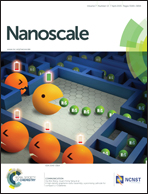Weaving a two-dimensional fishing net from titanoniobate nanosheets embedded with Fe3O4 nanocrystals for highly efficient capture and isotope labeling of phosphopeptides†
Abstract
Qualitative and quantitative characterization of phosphopeptides by means of mass spectrometry (MS) is the main goal of MS-based phosphoproteomics, but suffers from their low abundance in the large haystack of various biological molecules. Herein, we introduce two-dimensional (2D) metal oxides to tackle this biological separation issue. A nanocomposite composed of titanoniobate nanosheets embedded with Fe3O4 nanocrystals (Fe3O4–TiNbNS) is constructed via a facile cation-exchange approach, and adopted for the capture and isotope labeling of phosphopeptides. In this nanoarchitecture, the 2D titanoniobate nanosheets offer enlarged surface area and a spacious microenvironment for capturing phosphopeptides, while the Fe3O4 nanocrystals not only incorporate a magnetic response into the composite but, more importantly, also disrupt the restacking process between the titanoniobate nanosheets and thus preserve a greater specific surface for binding phosphopeptides. Owing to the extended active surface, abundant Lewis acid sites and excellent magnetic controllability, Fe3O4–TiNbNS demonstrates superior sensitivity, selectivity and capacity over homogeneous bulk metal oxides, layered oxides, and even restacked nanosheets in phosphopeptide enrichment, and further allows in situ isotope labeling to quantify aberrantly-regulated phosphopeptides from sera of leukemia patients. This composite nanosheet greatly contributes to the MS analysis of phosphopeptides and gives inspiration in the pursuit of 2D structured materials for separation of other biological molecules of interests.


 Please wait while we load your content...
Please wait while we load your content...